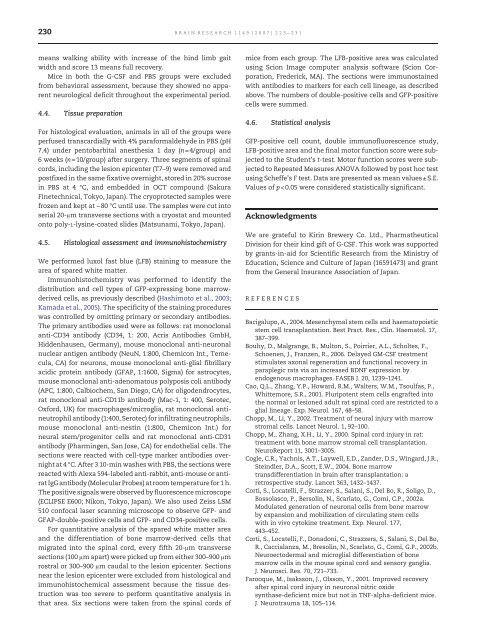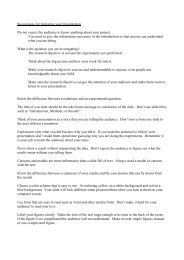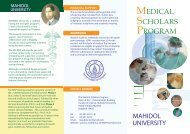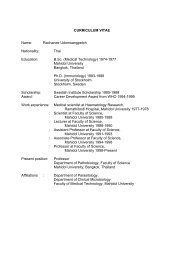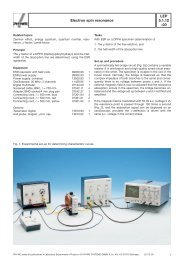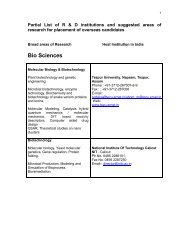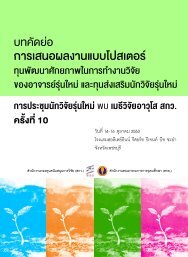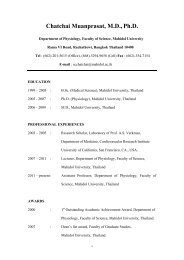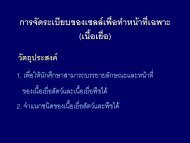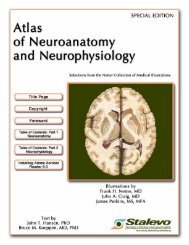230 BRAIN RESEARCH 1149 (2007) 223– 231 means walking ability with increase of the hind limb gait width and score 13 means full recovery. Mice in both the G-<strong>CSF</strong> and PBS groups were excluded from behavioral assessment, because they showed no apparent neurological deficit throughout the experimental period. 4.4. Tissue preparation For histological evaluation, animals in all of the groups were perfused transcardially with 4% paraformaldehyde in PBS (pH 7.4) under pentobarbital anesthesia 1 day (n=4/group) and 6 weeks (n=10/group) after surgery. Three segments of spinal cords, including the lesion epicenter (T7–9) were removed and postfixed in the same fixative overnight, stored in 20% sucrose in PBS at 4 °C, and embedded in OCT compound (Sakura Finetechnical, Tokyo, Japan). The cryoprotected samples were frozen and kept at −80 °C until use. The samples were cut into serial 20-μm transverse sections with a cryostat and mounted onto poly-L-lysine-coated slides (Matsunami, Tokyo, Japan). 4.5. Histological assessment and immunohistochemistry We performed luxol fast blue (LFB) staining to measure the area of spared white matter. Immunohistochemistry was performed to identify the distribution and cell types of GFP-expressing bone marrowderived cells, as previously described (Hashimoto et al., 2003; Kamada et al., 2005). The specificity of the staining procedures was controlled by omitting primary or secondary antibodies. The primary antibodies used were as follows: rat monoclonal anti-CD34 antibody (CD34, 1: 200, Acris Antibodies GmbH, Hiddenhausen, Germany), mouse monoclonal anti-neuronal nuclear antigen antibody (NeuN, 1:800, Chemicon Int., Temecula, CA) for neurons, mouse monoclonal anti-glial fibrillary acidic protein antibody (GFAP, 1:1600, Sigma) for astrocytes, mouse monoclonal anti-adenomatous polyposis coli antibody (APC, 1:800, Calbiochem, San Diego, CA) for oligodendrocytes, rat monoclonal anti-CD11b antibody (Mac-1, 1: 400, Serotec, Oxford, UK) for macrophages/microglia, rat monoclonal antineutrophil antibody (1:400, Serotec) for infiltrating neutrophils, mouse monoclonal anti-nestin (1:800, Chemicon Int.) for neural stem/progenitor cells and rat monoclonal anti-CD31 antibody (Pharmingen, San Jose, CA) for endothelial cells. The sections were reacted with cell-type marker antibodies overnight at 4 °C. After 3 10-min washes with PBS, the sections were reacted with Alexa 594-labeled anti-rabbit, anti-mouse or antirat IgG antibody (Molecular Probes) at room temperature for 1 h. The positive signals were observed by fluorescence microscope (ECLIPSE E600; Nikon, Tokyo, Japan). We also used Zeiss LSM 510 confocal laser scanning microscope to observe GFP- and GFAP-double-positive cells and GFP- and CD34-positive cells. For quantitative analysis of the spared white matter area and the differentiation of bone marrow-derived cells that migrated into the spinal cord, every fifth 20-μm transverse sections (100 μm apart) were picked up from either 300–900 μm rostral or 300–900 μm caudal to the lesion epicenter. Sections near the lesion epicenter were excluded from histological and immunohistochemical assessment because the tissue destruction was too severe to perform quantitative analysis in that area. Six sections were taken from the spinal cords of mice from each group. The LFB-positive area was calculated using Scion Image computer analysis software (Scion Corporation, Frederick, MA). The sections were immunostained with antibodies to markers for each cell lineage, as described above. The numbers of double-positive cells and GFP-positive cells were summed. 4.6. Statistical analysis GFP-positive cell count, double immunofluorescence study, LFB-positive area and the final motor function score were subjected to the Student's t-test. Motor function scores were subjected to Repeated Measures ANOVA followed by post hoc test using Scheffe's F test. Data are presented as mean values±S.E. Values of p
BRAIN RESEARCH 1149 (2007) 223– 231 231 Hashimoto, M., Koda, M., Ino, H., Murakami, M., Yamazaki, M., Moriya, H., 2003. Upregulation of osteopontin expression in rat spinal cord microglia after traumatic injury. J. Neurotrauma 20, 287–296. Herzog, E.L., Chai, L., Krause, D.S., 2003. Plasticity of marrow-derived stem cells. Blood 102, 3483–3493. Hofstetter, C.P., Schwarz, E.J., Hess, D., Widenfalk, J., El Manira, A., Prockop, D.J., Olson, L., 2002. Marrow stromal cells form guiding strands in the injured spinal cord and promote recovery. Proc. Natl. Acad. Sci. U. S. A. 19, 2199–2204. Jansen, J., Hanks, S., Thompson, J.M., Dugan, M.J., Akard, L.P., 2005. Transplantation of hematopoietic stem cells from the peripheral blood. J. Cell. Mol. Med. 9, 37–50. Kamada, T., Koda, M., Dezawa, M., Yoshinaga, K., Hashimoto, M., Koshizuka, S., Nishio, Y., Moriya, H., Yamazaki, M., 2005. Transplantation of Schwann cells derived from bone marrow stromal cells promotes axonal regeneration and functional recovery after complete transection of adult rat spinal cord. J. Neuropathol. Exp. Neurol. 64, 37–45. Kawada, H., Fujita, J., Kinjo, K., Matsuzaki, Y., Tsuma, M., Miyatake, H., Muguruma, Y., Tsuboi, K., Itabashi, Y., Ikeda, Y., Ogawa, S., Okano, H., Hotta, T., Ando, K., Fukuda, K., 2004. Nonhematopoietic mesenchymal stem cells can be mobilized and differentiate into cardiomyocytes after myocardial infarction. Blood 104, 3581–3587. Kawada, H., Takizawa, S., Takanashi, T., Morita, Y., Fujita, J., Fukuda, K., Takagi, S., Okano, H., Ando, K., Hotta, T., 2006. Administration of hematopoietic cytokines in the subacute phase after cerebral infarction is effective for functional recovery facilitating proliferation of intrinsic neural stem/progenitor cells and transition of bone marrow-derived neuronal cells. Circulation 113, 701–710. Koda, M., Okada, S., Nakayama, T., Koshizuka, S., Kamada, T., Nishio, Y., Someya, Y., Yoshinaga, K., Okawa, A., Moriya, H., Yamazaki, M., 2005. Hematopoietic stem cell and marrow stromal cell for spinal cord injury in mice. NeuroReport 16, 1763–1767. Koshizuka, S., Okada, S., Okawa, A., Koda, M., Murasawa, M., Hashimoto, M., Kamada, T., Yoshinaga, K., Murakami, M., Moriya, H., Yamazaki, M., 2004. Transplanted hematopoietic stem cells from bone marrow differentiate into neural lineage cells and promote functional recovery after spinal cord injury in mice. J. Neuropathol. Exp. Neurol. 63, 64–72. Nicola, N.A., Metcalf, D., Matsumoto, M., Johonson, G.R., 1983. Purification of a <strong>factor</strong> inducing differentiation in murine myelomonocytic leukemia cells. Identification as granulocyte <strong>colony</strong>-<strong>stimulating</strong> <strong>factor</strong>. J. Biol. Chem. 258, 9017–9023. Nishiki, S., Hato, F., Kamata, N., Sakamoto, E., Hasegawa, T., Kimura-Eto, A., Hino, M., Kitagawa, S., 2004. Selective activation of STAT 3 in human monocytes stimulated by G-<strong>CSF</strong>: implication in inhibition of LPS-induced TNF-α production. Am. J. Physiol.: Cell Physiol. 286, 1302–1311. Okabe, M., Ikawa, M., Kominami, K., Nakanishi, T., Nishimune, Y., 1997. ‘Green mice’ as a source of ubiquitous green cells. FEBS Lett. 407, 313–319. Orlic, D., Kajstura, J., Chimenti, S., Limana, F., Jakoniuk, I., Quaini, F., Nadal-Ginard, B., Bodine, D.M., Leri, A., Anversa, P., 2001. Mobilized bone marrow cells repair the infarcted heart, improving function and survival. Proc. Natl. Acad. Sci. U. S. A. 98, 10344–10349. Park, H.C., Shim, Y.S., Ha, Y., Yoon, S.H., Park, S.R., Choi, B.H., Park, H.S., 2005. Treatment of complete spinal cord injury patients by autologous bone marrow cell transplantation and administration of granulocyte–macrophage <strong>colony</strong> <strong>stimulating</strong> <strong>factor</strong>. Tissue Eng. 11, 913–922. Popovich, P.G., 2000. Immunological regulation of neuronal degeneration and regeneration in the injured spinal cord. Prog. Brain Res. 128, 43–58. Roberts, A.W., 2005. G-<strong>CSF</strong>: a key regulator of neutrophil production, but that's no all! Growth Factors 23, 33–41. Schneider, A., Krüger, C., Steigleder, T., Weber, D., Pitzer, C., Laage, R., Aronowski, J., Maurer, M.H., Gassler, N., Mier, W., Hasselblatt, M., Kollmar, R., Schwab, S., Sommer, C., Bach, A., Kuhn, H.G., Shäbitz, W.R., 2005. The hematopoietic <strong>factor</strong> G-<strong>CSF</strong> is a neuronal ligand that counteracts programmed cell death and drives neurogenesis. J. Clin. Invest. 115, 2083–2098. Shäbitz, W.R., Kollmar, R., Schwaninger, M., Juettler, E., Bardutzky, J., Schölzke, M.N., Sommer, C., Schwab, S., 2003. Neuroprotective effect of granulocyte <strong>colony</strong>-<strong>stimulating</strong> <strong>factor</strong> after focal cerebral ischemia. Stroke 34, 745–751. Sigurjonsson, O.E., Perreault, M.C., Egeland, T., Glover, J.C., 2005. Adult human hematopoietic stem cells produce neurons efficiently in the regenerating chicken embryo spinal cord. Proc. Natl. Acad. Sci. U. S. A. 102, 5227–5232. Takakura, N., Watanabe, T., Suenobu, S., Yamada, Y., Noda, T., Ito, Y., Satake, M., Suda, T., 2000. A role for hematopoietic stem cells in promoting angiogenesis. Cell 102, 199–209. Tondreau, T., Lagneaux, L., Dejeneffe, M., Massy, M., Mortier, C., Delforge, A., Bron, D., 2004. Bone marrow-derived mesenchymal stem cells already express specific neural proteins before any differentiation. Differentiation 72, 319–326. Urdzikova, L., Jendelova, P., Glogarova, K., Burian, M., Hajek, M., Sykova, E., 2006. Transplantation of bone marrow stem cells as well as mobilization by granulocyte-<strong>colony</strong> <strong>stimulating</strong> <strong>factor</strong> promotes recovery after spinal cord injury in rats. J. Neurotrauma 23, 1379–1391. Wu, S., Suzuki, Y., Ejiri, Y., Noda, T., Bai, H., Kitada, M., Kataoka, K., Ohta, M., Chou, H., Ide, C., 2003. Bone marrow stromal cells enhance differentiation of cocultured neurosphere cells and promote regeneration of injured spinal cord. J. Neurosci. Res. 72, 343–351. Zavala, F., Abad, S., Ezine, S., Taupin, V., Masson, A., Bach, J.F., 2002. G-<strong>CSF</strong> therapy of ongoing experimental allergic encephalomyelitis via chemokine- and cytokine-based immune deviation. J. Immunol. 168, 2011–2019.


